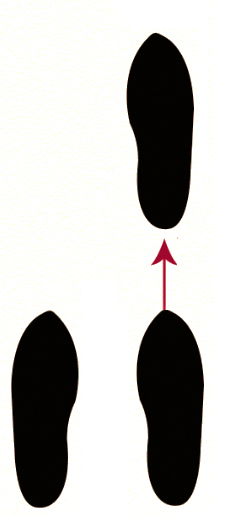A Journey Of A Thousand Miles
...Begins with the very first step. So do the Gekisai Kata, Ichi and Ni. In the Meibukan system of Gojyu Ryu, this is also  the way that the Kihon(basics) Kata begin. This step is different to almost every other step straight forward within the Goju Kata. Almost every other step is done as a 'C' Step or as some may phrase it, a circular step. This first step, in the very first Kata that you have to learn, is not one of those. From the Yoi or Heiko Dachi, with your feet parallel and pointing toward 12 O'Clock, this step is made as if sliding your right foot along a rail.
the way that the Kihon(basics) Kata begin. This step is different to almost every other step straight forward within the Goju Kata. Almost every other step is done as a 'C' Step or as some may phrase it, a circular step. This first step, in the very first Kata that you have to learn, is not one of those. From the Yoi or Heiko Dachi, with your feet parallel and pointing toward 12 O'Clock, this step is made as if sliding your right foot along a rail.
Since beginning Goju Ryu in 2005, after years of training in other system(s), I have wondered about that first step. Why is it different, and what possible purpose(s) could there be in that or those difference(s)? The significance of it being the first step of the first Kata, was not lost on me, and I now try to pass that on to my students.
Of course, it is important to see what happens on the completion of this step, for the completion is exactly the same through out the various Kihon Kata, from different schools, and also the 2 Gekisai Kata. For our school, there are 9 Kihon Kata, so with the 2 Gekisai Kata, that makes 11 Kata in which this single small step is made. Eleven Kata in which the practitioner steps forward then pivots with speed and aggression to his or her left, and executes the "block" as required by the specific Kata.
When looking at the bunkai(analysis) of this step and what follows, there appear to be many reasons we would step this way. The principle that I believe in when trying to ascertain the purpose of this, or any, move is that when I turn in Kata, I'm not being attacked from the side, but have moved to the side of my opponent. I also believe that it is ONLY the first move that is defensive in nature, and everything after that is devastatingly offensive.
I tend to also believe that Kata escalate in the quality of education they provide. Kihon Kata are "Basics" and the Gekisai Kata are "Beginner level" and because of this I think there maybe a lesson in being attacked from "the side". This step allows us to get off the line of attack, and also to create distance between us and the incoming attack. For those that have progressed, it could allow us to jam what ever is coming at us, as we move to the attackers side. When I use the terms basic, and beginner, I am referring purely to where the Kata appear in the the sequence of learning. I still think there are a great many advanced lessons one can learn from the "basic and beginner" Kata...
Beyond that, in my mind, it stands to reason that we would make exactly the same step on the other side, before pivoting to the right. In most cases I see the move to the other side as this; We finish the first 3 moves with a drop back from the Chudan Tsuki in Sanchin Dachi, to a Gedan Uke on our left in Shiko Dachi, with our heels on the same 9 O'Clock to 3 O'Clock line as we look to the left(9 O'clock) with our body facing forward (12 O'Clock). From here, what most people do is to basically step up to Sanchin Dachi, to execute the Jo Dan Age Uke with the right hand while facing the right(3 O'Clock). Personally, I believe that we have left a small but crucial part out. I believe that from the Shiko Dachi, we should come back to Heiko Dachi, take the small straight step with our left foot, and then continue on. This would allow us to examine the same options, and others, as with the left turn, but now on the other side.
Have a play with this and see what you think. If you're being "attacked" with a Jo Dan Tsuke, see what happens when your attacker, changes hands and attacks left instead of right, or vice versa. See what happens if he does attack from the side, then see what happens if he attacks from in front, and you move to his side. See if you can turn the Kata into a continuous flow of aggression against your attacker...
Of course I could be reading too much into it.To paraphrase Sigmund Freud when challenged on the significance of his cigar, Sometimes dear boy, a step is just a step... 😁
I am a huge fan of questioning everything.
Thanks For Reading, Please Feel Free To Leave Comments Good Or Bad.
Just Remember To Keep Them Civil With No Profanity.